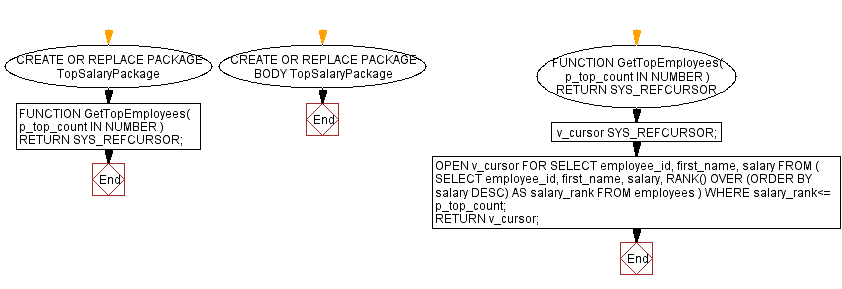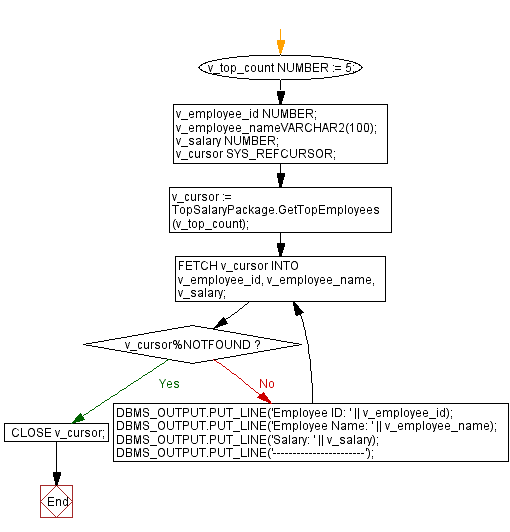PL/SQL Package: Top n employees with highest salary
PL/SQL Package: Exercise-11 with Solution
Write a PL/SQL package that contains a function to retrieve the top N employees with the highest salaries.
Sample Solution:
Table: employees
employee_id integer first_name varchar(25) last_name varchar(25) email archar(25) phone_number varchar(15) hire_date date job_id varchar(25) salary integer commission_pct decimal(5,2) manager_id integer department_id integer
PL/SQL Code:
CREATE OR REPLACE PACKAGE TopSalaryPackage IS
FUNCTION GetTopEmployees(
p_top_count IN NUMBER
) RETURN SYS_REFCURSOR;
END TopSalaryPackage;
/
CREATE OR REPLACE PACKAGE BODY TopSalaryPackage IS
FUNCTION GetTopEmployees(
p_top_count IN NUMBER
) RETURN SYS_REFCURSOR IS
v_cursor SYS_REFCURSOR;
BEGIN
OPEN v_cursor FOR
SELECT employee_id, first_name, salary
FROM (
SELECT employee_id, first_name, salary,
RANK() OVER (ORDER BY salary DESC) AS salary_rank
FROM employees
)
WHERE salary_rank<= p_top_count;
RETURN v_cursor;
END GetTopEmployees;
END TopSalaryPackage;
/
Sample Output:
Package created. Package Body created.
Flowchart:

To execute the package:
DECLARE
v_top_count NUMBER := 5;
v_employee_id NUMBER;
v_employee_nameVARCHAR2(100);
v_salary NUMBER;
v_cursor SYS_REFCURSOR;
BEGIN
v_cursor := TopSalaryPackage.GetTopEmployees(v_top_count);
LOOP
FETCH v_cursor INTO v_employee_id, v_employee_name, v_salary;
EXIT WHEN v_cursor%NOTFOUND;
DBMS_OUTPUT.PUT_LINE('Employee ID: ' || v_employee_id);
DBMS_OUTPUT.PUT_LINE('Employee Name: ' || v_employee_name);
DBMS_OUTPUT.PUT_LINE('Salary: ' || v_salary);
DBMS_OUTPUT.PUT_LINE('-----------------------');
END LOOP;
CLOSE v_cursor;
END;
/
Sample Output:
Statement processed. Employee ID: 100 Employee Name: Steven Salary: 24000 ----------------------- Employee ID: 101 Employee Name: Neena Salary: 17000 ----------------------- Employee ID: 102 Employee Name: Lex Salary: 17000 ----------------------- Employee ID: 145 Employee Name: John Salary: 14000 ----------------------- Employee ID: 146 Employee Name: Karen Salary: 13500 -----------------------
Flowchart:

Explanation:
The said code in Oracle's PL/SQL package that retrieves the top N employees with the highest salaries from the employees table by calling the function GetTopEmployees(p_top_count).
A function GetTopEmployees is declared inside the package. It takes a single input parameter p_top_count, which specifies the number of top employees to be retrieved.
The function returns a SYS_REFCURSOR, which is a special type of cursor used to return query results from the function.
A local variable v_cursor of type SYS_REFCURSOR is used to the function to hold the query results.
Within the function, a query is executed to select the employee_id, first_name, and salary from the employees table.
To determine the ranking of employees by salary, the RANK() window function is used in a subquery, ordering the employees in descending order of their salaries .
An additional column salary_rank represents the salary rank of each employee in the subquery result.
The main query then filters the results, returning only those employees whose salary_rank is less than or equal to the input parameter p_top_count.
Finally, the cursor v_cursor is opened for the constructed query, and it is returned as the result of the function.
Go to:
PREV : Calculate Bonus Package.
NEXT : Salary cost package in PL/SQL.
Have another way to solve this solution? Contribute your code (and comments) through Disqus.
What is the difficulty level of this exercise?
